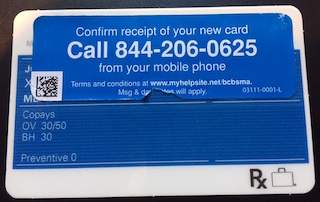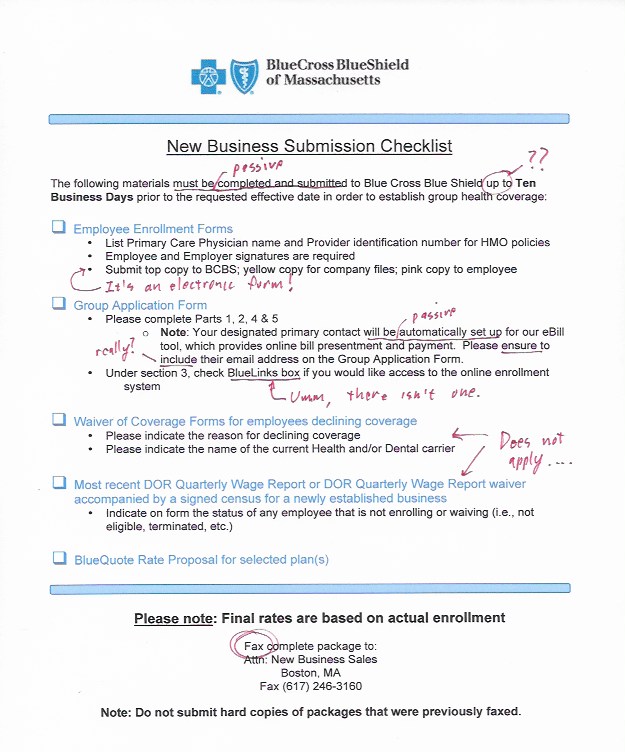How health insurance instructions and forms made me sick

Instructions are tricky. You need to be clear and brief, write directly to the user, and most importantly, make sure that the instructions match reality. Based on my experience with health insurance, this a prescription that Blue Cross Blue Shield of Massachusetts needs, stat.
I had previously used the excellent Blue Cross Blue Shield plan from my employer for the full 18 months that the COBRA law permits. I wanted to stay with the same insurer to maintain continuity with all of my family’s doctors and health services. Then I learned that I could save money by signing up as a one-person business rather than a family. (The savings is relative — it still costs an insane amount.)
Blue Cross sent me the quotes and then the forms I needed by email. And since the forms are complicated, they also sent me a convenient little checklist. And that’s where the trouble started, because of Bernoff’s first law of documentation:
Adding ambiguous instructions to an unclear form only makes it murkier.
(Yes, this is a riff on Brooks’ Law, which says that adding resources to a late project makes it later.)
If you think clarity of forms and instructions don’t matter, you’re way off. Think about all the time that customers waste puzzling out unclear instructions, in violation of the Iron Imperative. And think about all the phone calls that the company must receive and the errors it must untangle, all stemming from this lack of clarity. A few hours spent improving this form could save thousands of hours for customers and the company, and might actually bring our insurance rates down.
The form is at the bottom of this post, with my comments in red. Filling out these misleading forms was terrifying, because I knew that if I made one little error, I might lose my health insurance. Here’s what’s wrong with the instructions, and the lessons for people who write instructions:
- Never use passive voice in instructions. In a passive voice sentence, you can’t tell who is supposed to do what. For example, this form includes the sentences that say “The following materials must be submitted . . .” as well as “Your designated primary contact will be automatically set up . . .” Who’s submitting? Who’s setting it up? Instead, use “you” (“You must submit the following materials . . . “), “we” (“We will set up your designated primary contact . . .”) or a command (“Submit the following materials.”)
- Be very clear about deadlines. The instructions say the materials must be submitted “up to Ten Business Days prior to the requested effective date . . . ” (caps and bold in original). But that’s probably wrong. If they need ten business days to process, you’d have to submit at least ten days in advance. To draw attention to numbers like this, use numerals (“10” rather than “Ten”).
- Test your instructions and revise based on changes in reality. One of my favorite bits of this checklist is the instruction to send different colored copies of the form to people. Email attachments don’t have white, yellow, and pink carbon copies. Fail!
- Omit needless words. “Please ensure to include their email address . . .”? Just say “Make sure to put your primary contact’s email address . . . “
- Keep forms and instructions in sync. The instructions refer to a “BlueLinks box” that’s not on the form. I spent a few minutes searching for that.
- Be careful about conditional instructions. Two of the five items on the checklist ask me to do complicated things that don’t apply to a one-person firm like me. I could have saved some anxiety treatments if they’d been clearer about that. That’s scarier when you think they’ll reject you if you leave something out.
- Fax? Welcome to the 80’s! The instructions tell you to fax the package. Actually, of course, you can just email it. BCBS isn’t stuck in the 80’s — only the writer of these instructions is.
- Keep parallel materials consistent. On the second page of the form, BCBS of MA becomes intimidating, with a warning symbol and bold black type. There are four kinds of businesses, listed in four boxes, with four different ways to document that you’re actually a business. Of course, inside the first box are instructions that apply to all four types, not just that one. And the intimidating instructions for a “Newly established small business” sound as if they’ll apply to me — my business is 18 months old — but it turns out they don’t.
 Overall, consistency is paramount. This form includes commands, requests, passive-voice statements, lists of things where you have to do all of them, lists of things where you have to do one of them, color checklists, black-and-white admonishments, shaded tables, and long lists of instructions with an “April Fool, you may not need to do this” statement at the bottom of the list. It’s very clear that a committee wrote this. To put insecure form-fillers at ease and make things clear, the people at BCBS of MA should completely rewrite these instructions with a consistent voice and a consistent way to express it graphically.
Overall, consistency is paramount. This form includes commands, requests, passive-voice statements, lists of things where you have to do all of them, lists of things where you have to do one of them, color checklists, black-and-white admonishments, shaded tables, and long lists of instructions with an “April Fool, you may not need to do this” statement at the bottom of the list. It’s very clear that a committee wrote this. To put insecure form-fillers at ease and make things clear, the people at BCBS of MA should completely rewrite these instructions with a consistent voice and a consistent way to express it graphically.
In case you’re wondering, I succeeded. I got the insurance card in the mail. I called the phone number on the card. And then the recorded voice asked me for my insurance number . . . which, of course, wasn’t visible, because it was hidden under the sticker telling me what number to call. While I was frantically peeling the sticker off, a voice kept calling “Are you still there? We need you to type in the number!’
I’m still in therapy.

